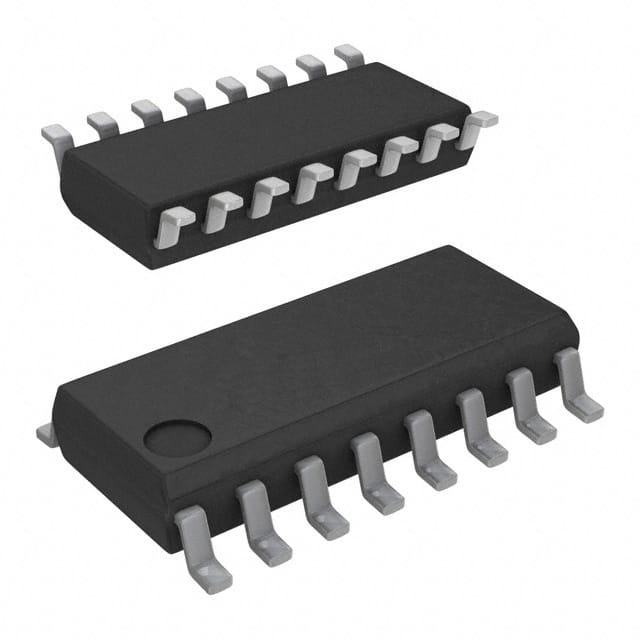Lihat spesifikasi untuk detail produk.

CD74HCT4051M
Product Overview
Category
CD74HCT4051M belongs to the category of integrated circuits (ICs).
Use
It is commonly used as a multiplexer/demultiplexer in electronic circuits.
Characteristics
- High-speed CMOS technology
- Low power consumption
- Wide operating voltage range
- 8-channel analog multiplexer/demultiplexer
Package
CD74HCT4051M is available in a standard 16-pin SOIC (Small Outline Integrated Circuit) package.
Essence
The essence of CD74HCT4051M lies in its ability to select one input from multiple sources and route it to a single output or vice versa.
Packaging/Quantity
CD74HCT4051M is typically sold in reels or tubes, with each reel/tube containing a specific quantity of ICs. The exact packaging and quantity may vary depending on the manufacturer.
Specifications
- Supply Voltage: 2V to 6V
- Input Voltage Range: GND to VCC
- On-state Resistance: 80Ω (typical)
- Channel-to-Channel Crosstalk: -70dB (typical)
- Operating Temperature Range: -40°C to +85°C
Detailed Pin Configuration
CD74HCT4051M has a total of 16 pins, which are assigned specific functions. The pin configuration is as follows:
- S0: Channel Select Input 0
- S1: Channel Select Input 1
- S2: Channel Select Input 2
- E: Enable Input
- Z: Common Output/Input
- Y0: Multiplexer Output/Demultiplexer Input 0
- Y1: Multiplexer Output/Demultiplexer Input 1
- Y2: Multiplexer Output/Demultiplexer Input 2
- Y3: Multiplexer Output/Demultiplexer Input 3
- Y4: Multiplexer Output/Demultiplexer Input 4
- Y5: Multiplexer Output/Demultiplexer Input 5
- Y6: Multiplexer Output/Demultiplexer Input 6
- Y7: Multiplexer Output/Demultiplexer Input 7
- VCC: Positive Power Supply
- GND: Ground
- NC: No Connection
Functional Features
- CD74HCT4051M can be used as an 8-channel analog multiplexer or demultiplexer.
- It has a wide operating voltage range, making it suitable for various applications.
- The high-speed CMOS technology ensures fast switching and data transfer.
- Low power consumption makes it energy-efficient.
Advantages and Disadvantages
Advantages
- Versatile functionality as both a multiplexer and demultiplexer.
- Wide operating voltage range allows compatibility with different systems.
- High-speed CMOS technology enables fast data transfer.
- Low power consumption helps conserve energy.
Disadvantages
- Limited number of channels (8) compared to some other multiplexers/demultiplexers.
- May require additional external components for certain applications.
Working Principles
CD74HCT4051M operates based on the principle of channel selection using binary inputs. The S0, S1, and S2 pins are used to select the desired channel. When a specific combination of these inputs is applied, the corresponding channel is activated, and the input signal is routed to the output pin (Y). The E pin is used to enable or disable the device.
Detailed Application Field Plans
CD74HCT4051M finds applications in various fields, including:
- Analog signal routing in audio/video equipment.
- Data acquisition systems.
- Communication systems.
- Industrial automation.
- Test and measurement equipment.
Detailed and Complete Alternative Models
Some alternative models that can be considered as alternatives to CD74HCT4051M are:
- CD4051B: 8-channel analog multiplexer/demultiplexer with similar characteristics.
- CD4052B: 4-channel analog multiplexer/demultiplexer with additional features.
- CD4053B: 2-channel analog multiplexer/demultiplexer with enhanced performance.
These alternative models offer similar functionality but may have different specifications or package options.
Word count: 515 words
Sebutkan 10 pertanyaan dan jawaban umum terkait penerapan CD74HCT4051M dalam solusi teknis
Sure! Here are 10 common questions and answers related to the application of CD74HCT4051M in technical solutions:
Q1: What is CD74HCT4051M? A1: CD74HCT4051M is a multiplexer/demultiplexer integrated circuit (IC) that allows multiple analog or digital signals to be selected and routed to a single output.
Q2: What is the purpose of CD74HCT4051M? A2: The purpose of CD74HCT4051M is to enable signal routing and selection in various electronic applications, such as audio/video systems, data acquisition systems, and communication devices.
Q3: How many channels does CD74HCT4051M have? A3: CD74HCT4051M has 8 channels, which means it can select and route signals from up to 8 different inputs to a single output.
Q4: What is the voltage range supported by CD74HCT4051M? A4: CD74HCT4051M supports a wide voltage range, typically from 2V to 10V, making it compatible with both TTL and CMOS logic levels.
Q5: Can CD74HCT4051M handle both analog and digital signals? A5: Yes, CD74HCT4051M can handle both analog and digital signals, allowing for versatile signal routing in mixed-signal applications.
Q6: How does CD74HCT4051M control signal selection? A6: CD74HCT4051M uses control pins to select the desired input channel. By setting the appropriate control pins high or low, the desired input can be connected to the output.
Q7: What is the maximum frequency supported by CD74HCT4051M? A7: CD74HCT4051M can handle frequencies up to several megahertz, making it suitable for a wide range of applications including audio and video signal routing.
Q8: Can CD74HCT4051M be cascaded to increase the number of channels? A8: Yes, multiple CD74HCT4051M ICs can be cascaded together to increase the number of channels available for signal selection.
Q9: Does CD74HCT4051M require external power supply? A9: Yes, CD74HCT4051M requires an external power supply typically in the range of 2V to 10V, depending on the specific application requirements.
Q10: Are there any precautions to consider when using CD74HCT4051M? A10: It is important to ensure that the voltage levels of the signals being routed through CD74HCT4051M are within its specified operating range. Additionally, proper decoupling capacitors should be used to minimize noise and ensure stable operation.

